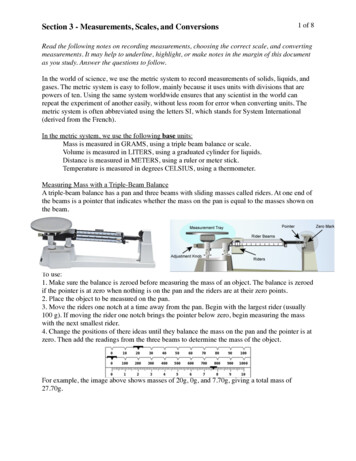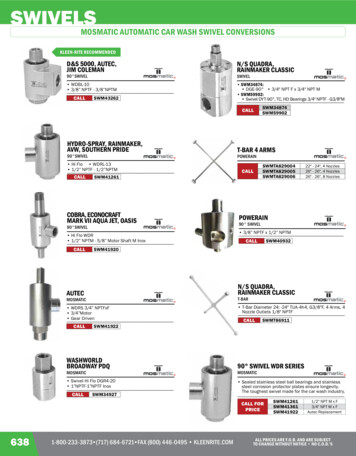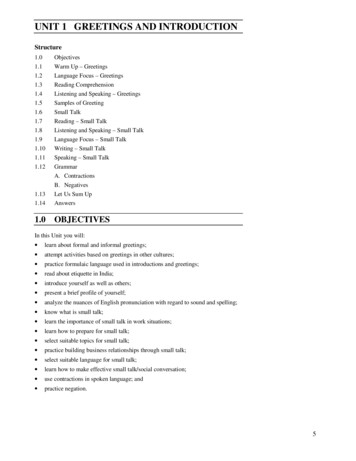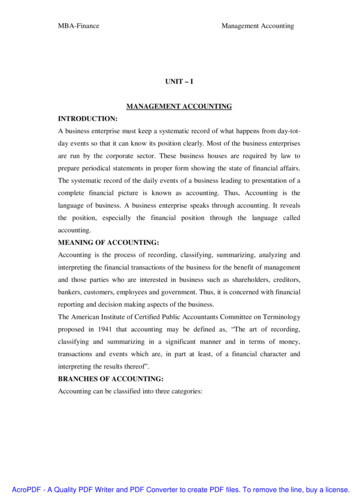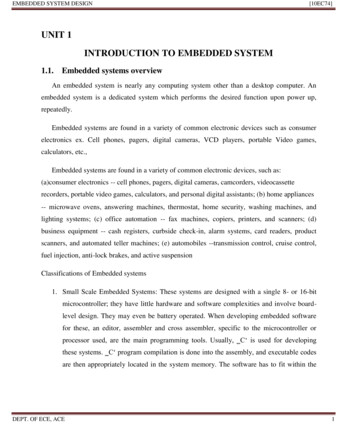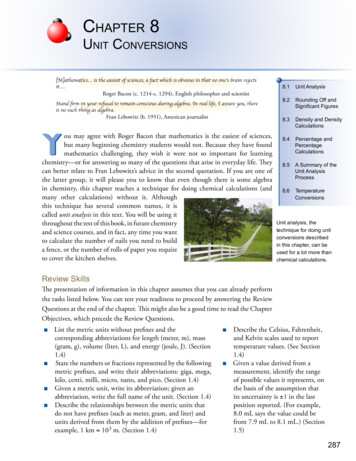
Transcription
Chapter 8Unit Conversions[M]athematics is the easiest of sciences, a fact which is obvious in that no one’s brain rejectsit .Roger Bacon (c. 1214-c. 1294), English philosopher and scientistStand firm in your refusal to remain conscious during algebra. In real life, I assure you, thereis no such thing as algebra.Fran Lebowitz (b. 1951), American journalistou may agree with Roger Bacon that mathematics is the easiest of sciences,but many beginning chemistry students would not. Because they have foundmathematics challenging, they wish it were not so important for learningchemistry—or for answering so many of the questions that arise in everyday life. Theycan better relate to Fran Lebowitz’s advice in the second quotation. If you are one ofthe latter group, it will please you to know that even though there is some algebrain chemistry, this chapter teaches a technique for doing chemical calculations (andmany other calculations) without it. Althoughthis technique has several common names, it iscalled unit analysis in this text. You will be using itthroughout the rest of this book, in future chemistryand science courses, and in fact, any time you wantto calculate the number of nails you need to builda fence, or the number of rolls of paper you requireto cover the kitchen shelves.8.1Unit Analysis8.2Rounding Off andSignificant Figures8.3Density and DensityCalculations8.4Percentage andPercentageCalculations8.5A Summary of theUnit AnalysisProcess8.6TemperatureConversionsUnit analysis, thetechnique for doing unitconversions describedin this chapter, can beused for a lot more thanchemical calculations.Review SkillsThe presentation of information in this chapter assumes that you can already performthe tasks listed below. You can test your readiness to proceed by answering the ReviewQuestions at the end of the chapter. This might also be a good time to read the ChapterObjectives, which precede the Review Questions.List the metric units without prefixes and thecorresponding abbreviations for length (meter, m), mass(gram, g), volume (liter, L), and energy (joule, J). (Section1.4)State the numbers or fractions represented by the followingmetric prefixes, and write their abbreviations: giga, mega,kilo, centi, milli, micro, nano, and pico. (Section 1.4)Given a metric unit, write its abbreviation; given anabbreviation, write the full name of the unit. (Section 1.4)Describe the relationships between the metric units thatdo not have prefixes (such as meter, gram, and liter) andunits derived from them by the addition of prefixes—forexample, 1 km 103 m. (Section 1.4)Describe the Celsius, Fahrenheit,and Kelvin scales used to reporttemperature values. (See Section1.4)Given a value derived from ameasurement, identify the rangeof possible values it represents, onthe basis of the assumption thatits uncertainty is 1 in the lastposition reported. (For example,8.0 mL says the value could befrom 7.9 mL to 8.1 mL.) (Section1.5)287
288Chapter 8Unit Conversions8.1 Unit AnalysisMany of the questions asked in chemistry and in everyday life can be answered byconverting one unit of measure into another. For example, suppose you are takingcare of your nephew for the weekend, and he breaks his arm. The doctor sets the arm,puts it in a cast, and prescribes an analgesic to help control the pain. Back at home,after filling the prescription, you realize that the label calls for 2 teaspoons of medicineevery six hours, but the measuring device that the pharmacy gave you is calibrated inmilliliters. You can’t find a measuring teaspoon in your kitchen, so you’ve got to figureout how many milliliters are equivalent to 2 tsp. It’s been a rough day, there’s a cryingboy on the couch, and you’re really tired. Is there a technique for doing the necessarycalculation that is simple and reliable? Unit analysis to the rescue!The main purpose of this chapter is to show you how to make many different typesof unit conversions, such as the one required above. You will find that the stepwisethought process associated with the procedure called unit analysis1 not only guides youin figuring out how to set up unit conversion problems but also gives you confidencethat your answers are correct.An Overview of the General ProcedureIn every affair, consider what precedes and follows, and then undertake it.Epictetus (c. 55-c. 135) Greek PhilosopherYou will see many different types of unit conversions in this chapter, but they can all beworked using the same general procedure. To illustrate the process, we will convert 2teaspoons to milliliters and solve the problem of how much medicine to give the littleboy described above.The first step in the procedure is to identify the unit for the value we want to calculate.We write this on the left side of an equals sign. Next, we identify the value that wewill convert into the desired value, and we write it on the right side of the equals sign.(Remember that a value constitutes both a number and a unit.) We want to know howmany milliliters are equivalent to 2 tsp. We express this question asNext, we multiply by one or more conversion factors that enable us to cancel theunwanted units and generate the desired units. A conversion factor is a ratio thatdescribes the relationship between two units. To create a conversion factor forconverting teaspoons to milliliters we can look in any modern cookbook (check itsindex under “metric conversions”) and discover that the relationship between teaspoonsand milliliters is1 tsp 5 mL1Unit analysis has other names, including the factor-label method, the conversion factor method, anddimensional analysis.
8.1 Unit AnalysisThis relationship can be used to produce two ratios, or conversion factors:The first of these can be used to convert teaspoons to milliliters, and the second can beused to convert milliliters to teaspoons.The final step in the procedure is to multiply the known unit (2 tsp) by the properconversion factor, the one that converts teaspoons to milliliters.Because 1 teaspoon is equivalent to 5 milliliters, multiplying by 5 mL/1 tsp is thesame as multiplying by 1. The volume associated with 2 tsp does not change when wemultiply by the conversion factor, but the value (number and unit) does. Because onemilliliter is one‑fifth the volume of one teaspoon, there are five times as many millilitersfor a given volume. Therefore, 2 tsp and 10 mL represent the same volume.Note that the units in a unit analysis setup cancel just like variables in an algebraicequation. Therefore, when we want to convert tsp to mL, we choose the ratio that hastsp on the bottom to cancel the tsp unit in our original value and leave us with thedesired unit of mL. If you have used correct conversion factors, and if your units cancelto yield the desired unit or units, you can be confident that you will arrive at the correctanswer.Metric‑Metric ConversionsAs you saw in Chapter 1, one of the convenient features of the metric system is thatthe relationships between metric units can be derived from the metric prefixes. Theserelationships can easily be translated into conversion factors. For example, milli- means10 -3 (or 0.001 or 1/1000), so a milliliter (mL) is 10 -3 liters (L). Thus there are 1000or 10 3 milliliters in a liter. (A complete list of the prefixes that you need to know tosolve the problems in this text is in Table 1.2.) Two possible sets of conversion factorsfor relating milliliters to liters can be obtained from these relationships.Objective 2Objective 2In the remainder of this text, metric‑metric conversion factors will have positiveexponents like those found in the first set of conversion factors above.289
290Chapter 8Unit ConversionsExample 8.1 - Conversion FactorsObjective 2Write two conversion factors that relate nanometers and meters. Use positive exponentsin each.SolutionNano- means 10 -9, so nanometer means 10 -9 meters.1 nm 10-9 m and 109 nm 1 mBecause we want our conversion factors to have positive exponents, we will build ourratios from the equation on the right (109 nm 1 m):Exercise 8.1 - Conversion FactorsObjective 2Write two conversion factors that relate the following pairs of metric units. Use positiveexponents for each.a.b.c.d.e.joule and kilojoulemeter and centimeterliter and gigalitergram and microgramgram and megagramExample 8.2 - Unit ConversionsObjective 3Convert 365 nanometers to kilometers.SolutionWe want the answer in kilometers (km), and the units we are given are nanometers(nm), so, we are converting from one metric length unit to another metric length unit.We begin by writing? km 365 nmWe continue constructing the unit analysis setup by writing the “skeleton” of a conversionfactor: the parentheses, the line dividing the numerator and the denominator, and theunit that we know we want to cancel. This step helps to organize our thoughts byshowing us that our first conversion factor must have the nm unit on the bottom tocancel the nm unit associated with 365 nm.
8.1 Unit AnalysisNote that in this problem both the desired metric unit and the known one haveprefixes. One way to make this type of conversion is to change the given unit to thecorresponding metric base unit, and then change that metric base unit to the desiredunit. We write two conversion factors, one for each of these changes.Sometimes it is useful to write a simple description of your plan first. Our plan inthis instance isnm m kmThe unit analysis setup would therefore beThe nm and m units cancel, leaving the answer in km.Exercise 8.2 - Unit ConversionsConvert 4.352 micrograms to megagrams.English-Metric ConversionsEnglish units2 are still common in some countries, while people in other countries(and the scientific community everywhere), use metric units almost exclusively. Unitanalysis provides a convenient method for converting between English and metricunits. Several of the most commonly needed English‑metric conversion factors arelisted in Table 8.1 on the next page. Because the English inch is defined as 2.54 cm,the number 2.54 in this value is exact. The numbers in the other conversion factors inTable 8.1 are not exact.2Table A.2 in Appendix A shows some useful English‑English conversion factors.Objective 3291
292Chapter 8Objective 4Unit ConversionsTable 8.1English-Metric Unit Conversion FactorsType ofmeasurementProbably most usefulto knowAlso useful to knowlengthSometimes the British areobstinate about the changefrom English to metric units.Greengrocer Steve Thoburnwent to jail for refusingto switch from pounds tokilograms.massvolumeExample 8.3 - Unit ConversionsObjective 5The mass of a hydrogen atom is 1.67 10 -18 micrograms. Convert this mass intopounds.SolutionWe start with? lb 1.67 10 -18 μgWe then add the skeleton of the first conversion factor.We are converting from metric mass to English mass. Table 8.1 contains a conversionfactor that is convenient for most English‑metric mass conversions, the one relatinggrams to pounds. Our given unit is micrograms. If we convert the micrograms intograms, we can then convert the gram unit into pounds.μg g lbExercise 8.3 - Conversion FactorsObjective 5The volume of the Earth’s oceans is estimated to be 1.5 1018 kiloliters. What is thisvolume in gallons?
8.2 Rounding Off and Significant Figures2938.2 Rounding and Significant FiguresMost of your calculations in chemistry are likely to be done using a calculator, andcalculators often provide more digits in the answer than you would be justified inreporting as scientific data. This section shows you how to round off an answer toreflect the approximate range of certainty warranted by the data.Measurements, Calculations, and UncertaintyIn Section 1.5, you read about the issue of uncertainty in measurement and learned toreport measured values to reflect this uncertainty. For example, an inexpensive letterscale might show you that the mass of a nickel is 5 grams, but this is not an exactmeasurement. It is reasonable to assume that the letter scale measures mass with aprecision of 1 g and that the nickel therefore has a mass between 4 grams and 6grams. You could use a more sophisticated instrument with a precision of 0.01 gand report the mass of the nickel as 5.00 g. The purpose of the zeros in this value is toshow that this measurement of the nickel’s mass has an uncertainty of plus or minus0.01 g. With this instrument, we can assume that the mass of the nickel is between4.99 g and 5.01 g. Unless we are told otherwise, we assume that values from measurementshave an uncertainty of plus or minus one in the last decimal place reported. Using a farmore precise balance found in a chemistry laboratory, you could determine the mass tobe 4.9800 g, but this measurement still has an uncertainty of 0.0001 g. Measurementsnever give exact values.Figure 2.1Measurement PrecisionEven highly precise measurements have some uncertainty. Each ofthese balances yields a different precision for the mass of a nickel.mass 5.0 gmeaning 4.9 g to 5.1 gmass 4.98 gmeaning 4.97 g to 4.99 gmass 4.9800 gmeaning 4.9799 g to 4.9801 g
294Chapter 8Unit ConversionsIf a calculation is performed using all exact values and if the answer is not roundedoff, the answer is exact, but this is a rare occurrence. The values used in calculations areusually not exact, and the answers should be expressed in a way that reflects the properdegree of uncertainty. Consider the conversion of the mass of our nickel from grams topounds. (There are 453.6 g per pound.)The number 4.9800 is somewhat uncertain because it comes from a measurement.The number 453.6 was derived from a calculation, and the answer to that calculationwas rounded off to four digits. Therefore, the number 453.6 is also uncertain. Thus anyanswer we obtain using these numbers is inevitably going to be uncertain as well.Different calculators or computers report different numbers of decimal places intheir answers. For example, perhaps a computer reports the answer to 4.9800 dividedby 453.6 as 0.01097883597884. If we were to report this result as the mass of ournickel, we would be suggesting that we were certain of the mass to a precision of 0.00000000000001, which is not the case. Instead, we report 0.01098 lb (or1.098 10-2 lb), which is a better reflection of the uncertainty in the numbers we usedto calculate our answer.Rounding Off Answers Derived from Multiplication and DivisionThere are three general steps to rounding off answers so that they reflect the uncertaintyof the values used in a calculation. Consider the example below, which shows how themass of a hydrogen atom in micrograms can be converted into the equivalent mass inpounds.The first step in rounding off is to decide which of the numbers in the calculationaffect the uncertainty of the answer. We can assume that 1.67 10-18 μg comes froma measurement, and all measurements are uncertain to some extent. Thus 1.67 10-18affects the uncertainty of our answer. The 106 number comes from the definition of themetric prefix micro-, so it is exact. Because it has no effect on the uncertainty of ouranswer, we will not consider it when we are deciding how to round off our answer. The453.6 comes from a calculation that was rounded off, so it is not exact. It affects theuncertainty of our answer and must be considered when we round our answer.The second step in rounding off is to consider the degree of uncertainty in eachof our inexact values. We can determine their relative uncertainties by counting thenumbers of significant figures: three in 1.67 10-18 and four in 453.6. The numberof significant figures, which is equal to the number of meaningful digits in a value,reflects the degree of uncertainty in the value (this is discussed more specifically inStudy Sheet 8.1). A larger number of significant figures indicates a smaller uncertainty.The final step is to round off our answer to reflect the most uncertain value usedin our calculation. When an answer is calculated by multiplying or dividing, we round itoff to the same number of significant figures as the inexact value with the fewest significantfigures. For our example, that value is 1.67 10-18 μg, with three significant figures, sowe round off the calculated result, 3.681657848325 10-27, to 3.68 10-27.
8.2 Rounding Off and Significant Figures295The following sample study sheet provides a detailed guide to rounding off numberscalculated using multiplication and division. (Addition and subtraction will be coveredin the subsequent discussion.) Examples 8.4 and 8.5 demonstrate these steps.Tip-off After calculating a number using multiplication and division, you need toround it off to the correct number of significant figures.General StepsStep 1 Determine whether each value is exact or not, and ignore exact values.Numbers that come from definitions are exact.Numbers in metric-metric conversion factors that are derived fromthe metric prefixes are exact, such asSample StudySheet 8.1RoundingOff NumbersCalculatedUsingMultiplicationand DivisionObjective 6Numbers in English-English conversion factors with the same type ofunit (for example, both length units) top and bottom are exact, suchasObjective 8The number 2.54 in the following conversion factor is exact.Numbers derived from counting are exact. For example, there are exactlyfive toes in the normal foot.Values that come from measurements are never exact.We will assume that values derived from calculations are not exact unlessotherwise indicated. (With one exception, the numbers relating Englishto metric units that you will see in this text have been calculated androunded, so they are not exact. The exception is 2.54 cm/1 in. The 2.54comes from a definition.)Step 2 Determine the number of significant figures in each value that is not exact.All non-zero digits are significant.Objective 7
296Chapter 8Unit ConversionsZeros between nonzero digits are significant.Zeros to the left of nonzero digits are not significant.Zeros to the right of nonzero digits in numbers that include decimal points aresignificant.Zeros to the right of nonzero digits in numbers without decimal points areambiguous for significant figures.Objective 8Step 3 When multiplying and dividing, round your answer off to the same numberof significant figures as the value containing the fewest significant figures.If the digit to the right of the final digit you want to retain is less than 5,round down (the last digit remains the same).
8.2 Rounding Off and Significant FiguresIf the digit to the right of the final digit you want to retain is 5 or greater,round up (the last significant digit increases by 1).Example See Examples 8.4 and 8.5.Example 8.4 - Rounding Off Answers Derived fromMultiplication and DivisionThe average human body contains 5.2 L of blood. What is this volume in quarts? Theunit analysis setup for this conversion is below. Identify whether each value in thesetup is exact or not. Determine the number of significant figures in each inexact value,calculate the answer, and report it to the correct number of significant figures.SolutionA typical calculator shows the answer to this calculation to be 5.4953765, a numberwith far too many decimal places, considering the uncertainty of the values used in thecalculation. It needs to be rounded to the correct significant figures.Step 1 The 5.2 L is based on measurement, so it is not exact. The 3.785 L ispart of an English-metric conversion factor, and we assume those factorsare not exact except for 2.54 cm/in. On the other hand, 4 qt/gal is anEnglish‑English conversion factor based on the definition of quart andgallon; thus the 4 is exact.Step 2 Because 5.2 contains two nonzero digits, it has two significant figures. Thenumber 3.785 contains four nonzero digits, so it has four significant figures.Step 3 Because the value with the fewest significant figures has two significantfigures, we report two significant figures in our answer, rounding 5.4953765to 5.5.Objective 8297
298Chapter 8Unit ConversionsExample 8.5 - Rounding Off Answers Derived fromMultiplication and DivisionObjective 8How many minutes does it take an ant walking at 0.01 m/s to travel 6.0 feet across apicnic table? The unit analysis setup for this conversion is below. Identify whether eachvalue in the setup is exact or not. Determine the number of significant figures in eachinexact value, calculate the answer, and report it to the correct number of significantfigures.SolutionStep 1 The table’s length and the ant’s velocity come from measurements, so 6.0 and0.01 are not exact. The other numbers are exact because they are derived fromdefinitions. Thus only 6.0 and 0.01 can limit our significant figures.Step 2 Zeros to the right of nonzero digits in numbers that have decimal points aresignificant, so 6.0 contains two significant figures. Zeros to the left of nonzerodigits are not significant, so 0.01 contains one significant figure.Step 3 A typical calculator shows 3.048 for the answer. Because the value with thefewest significant figures has one significant figure, we report one significantfigure in our answer. Our final answer of 3 minutes signifies that it could take2 to 4 minutes for the ant to cross the table.Exercise 8.4 - Rounding Off Answers Derived fromMultiplication and DivisionObjective 8A first‑class stamp allows you to send letters weighing up to 1 oz. (There are 16 ouncesper pound.) You weigh a letter and find it has a mass of 10.5 g. Can you mail thisletter with one stamp? The unit analysis setup for converting 10.5 g to ounces is below.Identify whether each value in the setup is exact or not. Determine the number ofsignificant figures in each inexact value, calculate the answer, and report it to the correctnumber of significant figures.
8.2 Rounding Off and Significant Figures299Exercise 8.5 - Rounding Off Answers Derived fromMultiplication and DivisionThe re-entry speed of the Apollo 10 space capsule was 11.0 km/s. How many hourswould it have taken for the capsule to fall through 25.0 miles of the stratosphere? Theunit analysis setup for this calculation is below. Identify whether each value in thesetup is exact or not. Determine the number of significant figures in each inexact value,calculate the answer, and report it to the correct number of significant figures.Objective 8Rounding Off Answers Derived from Addition and SubtractionThe following sample study sheet provides a guide to rounding off numbers calculatedusing addition and subtraction.Tip-off After calculating a number using addition and subtraction, you need to Sample Studyround it off to the correct number of decimal positions.Sheet 8.2General StepsStep 1 Determine whether each value is exact, and ignore exact values (see StudySheet 8.1).Step 2 Determine the number of decimal places for each value that is not exact.Step 3 Round your answer to the same number of decimal places as the inexact valuewith the fewest decimal places.Example See Example 8.6.RoundingOff NumbersCalculated UsingAddition andSubtractionObjective 9
300Chapter 8Unit ConversionsExample 8.6 - Rounding Off Answers Derived fromAddition and SubtractionObjective 9A laboratory procedure calls for you to determine the mass of an unknown liquid.Let’s suppose that you weigh a 100‑mL beaker on a new electronic balance and recordits mass as 52.3812 g. You then add 10 mL of the unknown liquid to the beakerand discover that the electronic balance has stopped working. You find a 30-year-oldbalance in a cupboard, use it to weigh the beaker of liquid, and record that mass as60.2 g. What is the mass of the unknown liquid?SolutionYou can calculate the mass of the liquid by subtracting the mass of the beaker from themass of the beaker and the liquid.60.2 g beaker with liquid - 52.3812 g beaker 7.8188 g liquidWe can use the steps outlined in Sample Study Sheet 8.2 to decide how to round offour answer.Step 1 The numbers 60.2 and 52.3812 come from measurements, so they are notexact.Step 2 We assume that values given to us have uncertainties of 1 in the last decimalplace reported, so 60.2 has an uncertainty of 0.1 g and 52.3812 has anuncertainty of 0.0001 g. The first value is precise to the tenths place, andthe second value is precise to four places to the right of the decimal point.Step 3 We round answers derived from addition and subtraction to the samenumber of decimal places as the value with the fewest. Therefore, we reportour answer to the tenth’s place—rounding it off if necessary—to reflect thisuncertainty. The answer is 7.8 g.Be sure to remember that the guidelines for rounding answers derived fromaddition or subtraction are different from the guidelines for rounding answers frommultiplication or division. Notice that when we are adding or subtracting, we areconcerned with decimal places in the numbers used rather than with the number ofsignificant figures. Let’s take a closer look at why. In Example 8.6, we subtracted themass of a beaker (52.3812 g) from the mass of the beaker and an unknown liquid(60.2 g) to get the mass of the liquid. If the reading of 60.2 has an uncertainty of 0.1 g, the actual value could be anywhere between 60.1 g and 60.3 g. The range ofpossible values for the mass of the beaker is 52.3811 g to 52.3813 g. This leads to arange of possible values for our answer from 7.7187 g to 7.9189 g.Note that our possible values vary from about 7.7 g to about 7.9 g, or 0.1 of ourreported answer of 7.8 g. Because our least precise value (60.2 g) has an uncertainty of 0.1 g, our answer can be no more precise than 0.1 g.
8.2 Density and Density CalculationsUse the same reasoning to prove that the following addition and subtraction problemsare rounded to the correct number of decimal positions.301Objective 997.40 31 1281035.67 - 989.2 46.5Note that although the numbers in the addition problem have four and two significantfigures, the answer is reported with three significant figures. This answer is limited tothe ones place by the number 31, which we assume has an uncertainty of 1. Note alsothat although the numbers in the subtraction problem have six and four significantfigures, the answer has only three. The answer is limited to the tenths place by 989.2,which we assume has an uncertainty of 0.1.Exercise 8.6 - Rounding Off Answers Derived fromAddition and SubtractionReport the answers to the following calculations to the correct number of decimalObjective 9positions. Assume that each number is 1 in the last decimal position reported.a. 684 - 595.325 b. 92.771 9.3 8.3Density and Density CalculationsWhen people say that lead is heavier than wood, they do not meanthat a pea‑sized piece of lead weighs more than a truckload ofpine logs. What they mean is that a sample of lead will have agreater mass than an equal volume of wood. A more concise wayof putting this is that lead is more dense than wood. This type ofdensity, formally known as mass density, is defined as mass dividedby volume. It is what people usually mean by the term density.The density of lead is 11.34 g/mL, and the density of pinewood is about 0.5 g/mL.In other words, a milliliter of lead contains 11.34 g of matter, while a milliliter ofpine contains only about half a gram of matter. See Table 8.2 on the next page for thedensities of other common substances.Although there are exceptions, the densities of liquids and solids generally decreasewith increasing temperature3. Thus, when chemists report densities, they generallystate the temperature at which the density was measured. For example, the density ofethanol is 0.806 g/mL at 0 C but 0.789 g/mL at 20 C.43 Thedensity of liquid water actually increases as its temperature rises from 0 C to 4 C. Suchexceptions are very rare.4 The temperature effect on the density of gases is more complicated, but it, too, changes with changesin temperature. This effect will be described in Chapter 13.A truckload of logs ismuch heavier (hasgreater mass) than apea-sized amount oflead, but the density oflead is much greaterthan that of wood.
302Chapter 8Unit ConversionsObjective 10Figure 8.2Densities of Some CommonSubstances.The densities of liquids and solids are usually described in grams per milliliteror grams per cubic centimeter. (Remember a milliliter and a cubic centimeter arethe same volume.) The particles of a gas are much farther apart than the particlesof a liquid or solid, so gases are much less dense than solids and liquids. Thus it ismore convenient to describe the densities of gases as grams per liter. The densityof air at sea level and 20 C is about 1.2 g/L.Because the density of a substance depends on the substance’s identity and itstemperature, it is possible to identify an unknown substance by comparing itsdensity at a particular temperature to the densities of known substances at thesame temperature. For example, we can determine whether an object is puregold by measuring its density at 20 C and comparing that to the known densityof gold at 20 C, 19.31 g/mL. Figure 8.2 shows densities of some commonsubstances.Table 8.2Mass Densities of Some Common Substances (at 20 C unlessotherwise stated)Substanceair at sea levelStyrofoampinewoodgasolineethanolicewater, H2O, at 20 Cwater, H2O, at 0 Cwater, H2O, at 3.98 Cseawaterwhole bloodboneglassaluminum, Althe planet Earth (average)iron, Fesilver, Aggold, Aulead, Pbplatinum, Ptatomic nucleusa black hole (not 20 C)Density, g/mL0.0012 (or 1.2 45 1014 1016
8.3 Density and Density CalculationsUsing Density as a Conversion FactorBecause density is reported as a ratio that describes a relationship between two units, thedensity of a substance can be used in unit analysis to convert between the substance’smass and its volume. Examples 8.7 and 8.8 show how the density of water at 20 Ccan be used to convert between the mass in grams of a given sample of water and thesample’s volume in mil
that your answers are correct. An Overview of the General Procedure. In every affair, consider what precedes and follows, and then undertake it. Epictetus (c. 55-c. 135) Greek Philosopher. You will see many different types of unit conversions in this chapter, but

